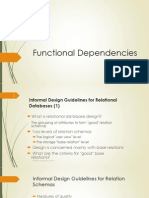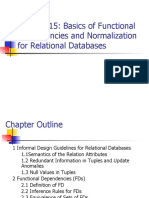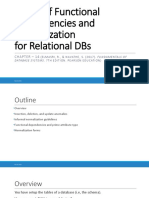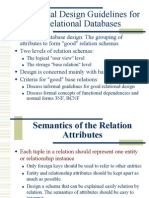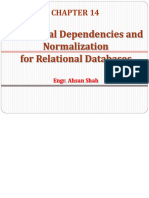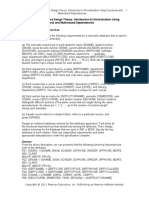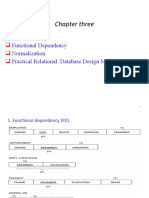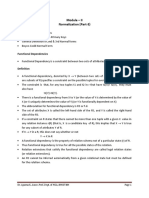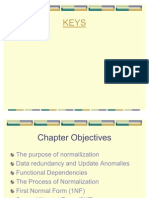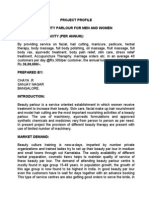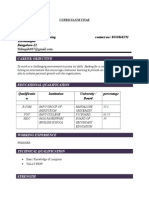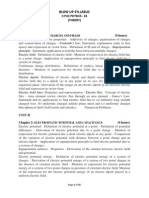Database Management System
Database Management System
Uploaded by
Arham JainCopyright:
Available Formats
Database Management System
Database Management System
Uploaded by
Arham JainOriginal Description:
Original Title
Copyright
Available Formats
Share this document
Did you find this document useful?
Is this content inappropriate?
Copyright:
Available Formats
Database Management System
Database Management System
Uploaded by
Arham JainCopyright:
Available Formats
Database Management System
VTU-EDUSAT Page 1
UNIT -6
Database Design
Informal Design Guidelines for Relation Schemas; Functional Dependencies;
Normal Forms Based on Primary Keys; General Definitions of Second and
Third Normal Forms; Boyce-Codd Normal Form.
Fourth Normal Form; and Fifth Normal Form;
INFORMAL DESIGHN GUIDELINES FOR RELATIONAL SCHEMA
1.Semantics of the Attributes
2.Reducing the Redundant Value in Tuples.
3.Reducing Null values in Tuples.
4.Dissallowing spurious Tuples.
1. Semantics of the Attributes
Whenever we are going to form relational schema there should be some meaning
among the attributes.This meaning is called semantics.This semantics relates one
attribute to another with some relation.
Eg:
USN No Student name Sem
2. Reducing the Redundant Value in Tuples
Mixing attributes of multiple entities may cause problems
Information is stored redundantly wasting storage
Problems with update anomalies
Insertion anomalies
Deletion anomalies
Modification anomalies
Database Management System
VTU-EDUSAT Page 2
The main goal of the schema diagram is to minimize the storage space that the base
memory occupies.Grouping attributes information relations has asignificant effect on
storage space.
Eg;
USN No Student name Sem
Eg:
Dept No Dept Name
If we integrate these two and is used as a single table i.e Student Table
USN No Student name Sem Dept No Dept Name
Here whenever if we insert the tuples there may be N stunents in one department,so
Dept No,Dept Name values are repeated N times which leads to data redundancy.
Another problem is updata anamolies ie if we insert new dept that has no students.
If we delet the last student of a dept,then whole information about that department will be
deleted
If we change the value of one of the attributes of aparticaular table the we must update
the tuples of all the students belonging to thet depy else Database will become
inconsistent.
Note: Design in such a way that no insertion ,deletion,modification anamolies will occur
3. Reducing Null values in Tuples.
Note: Relations should be designed such that their tuples will have as few NULL
values as possible
Attributes that are NULL frequently could be placed in separate relations (with the
primary key)
Reasons for nulls:
attribute not applicable or invalid
attribute value unknown (may exist)
Database Management System
VTU-EDUSAT Page 3
value known to exist, but unavailable
4. Disallowing spurious Tuples
Bad designs for a relational database may result in erroneous results for certain JOIN
operations
The "lossless join" property is used to guarantee meaningful results for join
operations
Note: The relations should be designed to satisfy the lossless join condition. No
spurious tuples should be generated by doing a natural-join of any relations.
Functional dependency
1. Functional dependencies (FDs) are used to specify formal measures of the
"goodness" of relational designs
2. FDs and keys are used to define normal forms for relations
3. FDs are constraints that are derived from the meaning and interrelationships of
the data attributes
4. X->Y : A set of attributes X functionally determines a set of attributes Y if the
value of X determines a unique value for Y
5. X -> Y holds if whenever two tuples have the same value for X, they must have
the same value for Y
6. For any two tuples t1 and t2 in any relation instance r(R): If t1[X]=t2[X], then
t1[Y]=t2[Y]
7. X -> Y in R specifies a constraint on all relation instances r(R)
8. Written as X -> Y; can be displayed graphically on a relation schema as in
Figures. ( denoted by the arrow: ).
9. FDs are derived from the real-world constraints on the attributes
10. social security number determines employee name
SSN -> ENAME
11.project number determines project name and location
PNUMBER -> {PNAME, PLOCATION}
11. employee ssn and project number determines the hours per week that the
employee works on the project
Database Management System
VTU-EDUSAT Page 4
{SSN, PNUMBER} -> HOURS
Inference rules for FDs:
Inference rules also known as Armstrong's Axioms are published by Armstrong. These
properties are as given below:
1. Reflexivity property: X ->Y is true if Y is subset of X.
2. Augmentation property: If X->Y is true, then
XZ ->YZ is also true.
3. Transitivity property: If X->Y and Y->Z then
X ->Z is implied.
4. Union property: If X ->Y and X ->Z are true, then
X ->YZ is also true. This property indicates that if right hand side of FD contains
many attributes then FD exists for each of them.
5. Decomposition property: If X ->Y is implied and Z is subset of Y, then X ->Z is
implied. This property is the reverse of union property.
6. Pseudotransitivity property: If X ->Y and WY ->Z are given, then XW ->Z is
true.
Normalization:
Normalizing the database ensures the following things:
Dependencies between data are identified.
Redundant data is minimized.
The data model is flexible and easier to maintain
Normalization: The process of decomposing unsatisfactory "bad" relations by
breaking up their attributes into smaller relations
Normal form: Condition using keys and FDs of a relation to certify whether a
relation schema is in a particular normal form
Database Management System
VTU-EDUSAT Page 5
FIRST NORMAL FORM
The purpose of first normal form (1NF) is to eliminate repeating groups of
attributes in an entity.
Disallows composite attributes, multivalued attributes, and nested relations;
attributes whose values for an individual tuple are non-amanjuic
Consider the following
table:
SECOND NORMAL FORM
The purpose of second normal form (2NF) is to eliminate partial key
dependencies.
Each attribute in an entity must depend on the whole key, not just a part of it.
Database Management System
VTU-EDUSAT Page 6
THIRD NORMAL FORM
Third Normal form also helps to eliminate redundant information by eliminating
interdependencies between non-key attributes.
It is already in 2NF
There are no non-key attributes that depend on another non-key attribute
Database Management System
VTU-EDUSAT Page 7
General Normal Form Definitions (For Multiple Keys)
The above definitions consider the primary key only
The following more general definitions take into account relations with multiple
candidate keys
A relation schema R is in second normal form (2NF) if every non-prime attribute A
in R is fully functionally dependent on every key of R
Definition:
Superkey of relation schema R - a set of attributes S of R that contains a key of R
A relation schema R is in third normal form (3NF) if whenever a FD X -> A holds
in R, then either:
X is a superkey of R, or
A is a prime attribute of R
Example 1
CUSTOMER
CustomerID Firstname Surname City PostCode
12123 Harry Enfield London SW7 2AP
12443 Leona Lewis London WC2H 7JY
354 Sarah Brightman Coventry CV4 7AL
Database Management System
VTU-EDUSAT Page 8
This is not in strict 3NF as the City could be obtained from the Post code attribute. If you
create a table containing postcodes then city could be derived.
CustomerID Firstname Surname PostCode*
12123 Harry Enfield SW7 2AP
12443 Leona Lewis WC2H 7JY
354 Sarah Brightman CV4 7AL
POSTCODES
PostCode City
SW7 2AP London
WC2H 7JY London
CV4 7AL Coventry
Example 2.
VideoID Title Certificate Description
12123 Saw IV 18 Eighteen and over
12443 Igor PG Parental Guidance
354 Bambi U Universal Classification
The Description of what the certificate means could be obtained frome the certifcate
attribute - it does not need to refer to the primary key VideoID. So split it out and use the
primary key / secondary key approach.
Example 3
CLIENT
ClientID CinemaID* CinemaAddress
12123 LON23 1 Leicester Square. London
12443 COV2 34 Bramby St, Coventry
354 MAN4 56 Croydon Rd, Manchester
CINEMAS
CinemaID CinemaAddress
LON23 1 Leicester Square. London
Database Management System
VTU-EDUSAT Page 9
COV2 34 Bramby St, Coventry
MAN4 56 Croydon Rd, Manchester
In this case the database is almost in 3NF - for some reason the Cinema Address is being
repeated in the Client table, even though it can be obtained from the Cinemas table. So
simply remove the column from the client table
BOYCE-CODD NORMAL FORM (BCNF)
A relation schema R is in Boyce-Codd Normal Form (BCNF) if whenever an FD X
-> A holds in R, then X is a superkey of R
Each normal form is strictly stronger than the previous one
Every 2NF relation is in 1NF
Every 3NF relation is in 2NF
Every BCNF relation is in 3NF
There exist relations that are in 3NF but not in BCNF
The goal is to have each relation in BCNF (or 3NF)
Definition:
A multivalued dependency (MVD) X >> Y specified on relation
schema R, where X and Y are both subsets of R, specifies the
following constraint on any relation state r of R: If two tuples t1 and t2
exist in r such that t1[X] = t2[X], then two tuples t3 and t4 should also
Database Management System
VTU-EDUSAT Page 10
exist in r with the following properties, where we use Z to denote
(R - (X Y)):
t3[X] = t4[X] = t1[X] = t2[X].
t3[Y] = t1[Y] and t4[Y] = t2[Y].
t3[Z] = t2[Z] and t4[Z] = t1[Z].
An MVD X >> Y in R is called a trivial MVD if (a) Y is a subset of
X, or (b) X Y = R.
Fourth Normal Form (4NF)
Fourth normal form eliminates independent many-to-one relationships between
columns.
To be in Fourth Normal Form,
a relation must first be in Boyce-Codd Normal Form.
a given relation may not contain more than one multi-valued attribute.
Defined as a relation that is in Boyce-Codd Normal Form and contains no
nontrivial multi-valued dependencies.
Example
Database Management System
VTU-EDUSAT Page 11
Fifth Normal Form (5NF)
A relation decompose into two relations must have the lossless-join property,
which ensures that no spurious tuples are generated when relations are reunited
through a natural join operation.
However, there are requirements to decompose a relation into more than two
relations. Although rare, these cases are managed by join dependency and fifth
normal form (5NF).
Constraints as Assertions
Database Management System
VTU-EDUSAT Page 12
General constraints: constraints that do not fit in
the basic SQL categories
Mechanism: CREAT ASSERTION
Components include:
a constraint name,
followed by CHECK,
followed by a condition
Assertions: An Example
The salary of an employee must not be greater
than the salary of the manager of the department
that the employee works for
CREAT ASSERTION SALARY_CONSTRAINT
CHECK (NOT EXISTS (SELECT *
FROM EMPLOYEE E, EMPLOYEE M,
DEPARTMENT D
WHERE E.SALARY > M.SALARY AND
E.DNO=D.NUMBER AND
D.MGRSSN=M.SSN))
SQL Triggers
Objective: to monitor a database and take initiate action when a
condition occurs
Triggers are expressed in a syntax similar to assertions and
include the following:Event
Such as an insert, deleted, or update operation
Condition
Action
To be taken when the condition is satisfied
SQL Triggers: An Example
A trigger to compare an employees salary to his/her
supervisor during insert or update operations:
CREATE TRIGGER INFORM_SUPERVISOR
BEFORE INSERT OR UPDATE OF
SALARY, SUPERVISOR_SSN ON EMPLOYEE
FOR EACH ROW
WHEN
(NEW.SALARY> (SELECT SALARY FROM EMPLOYEE
WHERE SSN=NEW.SUPERVISOR_SSN))
INFORM_SUPERVISOR (NEW.SUPERVISOR_SSN,NEW.SSN);
You might also like
- NormalizationDocument62 pagesNormalizationKapil SinghalNo ratings yet
- 13 - Functional DependenciesDocument36 pages13 - Functional DependenciesFahad KhosaNo ratings yet
- Semantics of The Relation Attributes: Each Tuple in A Relation Should Represent One Entity or Relationship InstanceDocument36 pagesSemantics of The Relation Attributes: Each Tuple in A Relation Should Represent One Entity or Relationship InstanceFaizan AshrafNo ratings yet
- Lecture 10: BCSE302L - DBMS: Functional DependenciesDocument35 pagesLecture 10: BCSE302L - DBMS: Functional DependenciesPriyanshu SinghNo ratings yet
- Unit-III Part - IDocument35 pagesUnit-III Part - IRamaswamy MuthukrishnanNo ratings yet
- Chapter 15: Basics of Functional Dependencies and Normalization For Relational DatabasesDocument65 pagesChapter 15: Basics of Functional Dependencies and Normalization For Relational DatabasesUsman IlamdinNo ratings yet
- Unit 6 RDB DesignDocument103 pagesUnit 6 RDB Designraazoo19No ratings yet
- NF PDFDocument98 pagesNF PDFganji snehalathaNo ratings yet
- Unit 9 Functional Dependencies and Normalization For Relational DatabasesDocument20 pagesUnit 9 Functional Dependencies and Normalization For Relational DatabasesgaardiNo ratings yet
- NORMALIZATIONDocument51 pagesNORMALIZATIONAishwarya PillaiNo ratings yet
- Unit 3 Updated FGDocument16 pagesUnit 3 Updated FGVasantha KumariNo ratings yet
- Unit-Iv: I. Pitfalls in Relational Database DesignDocument23 pagesUnit-Iv: I. Pitfalls in Relational Database DesignQWERTYyuioooooooooNo ratings yet
- Functional Dependencies and Normalization For Relational DatabasesDocument36 pagesFunctional Dependencies and Normalization For Relational DatabaseschhatraNo ratings yet
- Relational Design and Functional Dependency: InformationDocument7 pagesRelational Design and Functional Dependency: InformationGita PanickerNo ratings yet
- MODULE-3 DBMS CS208 NOTES (Ktuassist - In)Document4 pagesMODULE-3 DBMS CS208 NOTES (Ktuassist - In)KalNo ratings yet
- Module-Iv Normalization of Database Tables Database Tables and NormalizationDocument17 pagesModule-Iv Normalization of Database Tables Database Tables and Normalizationsoujanya muthyalaNo ratings yet
- DBMS Module 04Document33 pagesDBMS Module 04shariffayan91No ratings yet
- CH 14 FDs and Normalization PDFDocument55 pagesCH 14 FDs and Normalization PDFBasant prajapatiNo ratings yet
- 4 - Unit4 - CS52 - DBS - 29th Dec 2022Document18 pages4 - Unit4 - CS52 - DBS - 29th Dec 2022KushagraNo ratings yet
- SQL Overview: Data Definition LanguageDocument9 pagesSQL Overview: Data Definition Languagesrii21rohithNo ratings yet
- Dbms Module 3Document12 pagesDbms Module 3csmic.2022No ratings yet
- Relational Data Model and Relational Constraints-CISDocument24 pagesRelational Data Model and Relational Constraints-CISFatima AhmedNo ratings yet
- DBMS - Unit 4Document27 pagesDBMS - Unit 4Yashaswini SNo ratings yet
- UntitledDocument25 pagesUntitledgouvany tamerNo ratings yet
- Unit 3Document23 pagesUnit 3Karthikeyan RamajayamNo ratings yet
- Module-3 DBMS CS208 NotesDocument4 pagesModule-3 DBMS CS208 NotesmujeebNo ratings yet
- Vtu 5TH Sem Cse DBMS NotesDocument35 pagesVtu 5TH Sem Cse DBMS NotesNeha Chinni67% (3)
- CH 14 ADocument18 pagesCH 14 ASohini NayakNo ratings yet
- Chapter 14Document54 pagesChapter 14taimoor.giki.csNo ratings yet
- 3 RelationalmodelDocument49 pages3 RelationalmodelPengkuh Ardi NugrahaNo ratings yet
- Dbms Imp NotesDocument5 pagesDbms Imp NotesRishi Raj K0% (1)
- Functional Dependency and NormalizationDocument10 pagesFunctional Dependency and NormalizationDo Van TuNo ratings yet
- Elmasri 6e - ISM 15Document11 pagesElmasri 6e - ISM 15Reynald FitriyadiNo ratings yet
- Unit 4 Databasedesign: Functional Dependencies and Normalization Informal Design Guidelines For Relation SchemasDocument24 pagesUnit 4 Databasedesign: Functional Dependencies and Normalization Informal Design Guidelines For Relation SchemasKaran JagannathNo ratings yet
- Normalization PDFDocument29 pagesNormalization PDFSanath KumarNo ratings yet
- Relational Database DesignDocument52 pagesRelational Database DesignTanisha RathodNo ratings yet
- Summary-Booklet - Jenna TutorialsDocument15 pagesSummary-Booklet - Jenna TutorialsjdsterNo ratings yet
- Spatial Data Base Chapter+Three +Practical+Database+Design 4th YearDocument26 pagesSpatial Data Base Chapter+Three +Practical+Database+Design 4th YearhabteNo ratings yet
- Metadata Refers To Data About DataDocument24 pagesMetadata Refers To Data About DataAndreea VonicaNo ratings yet
- DBMSDocument123 pagesDBMSVenkataramanan SureshNo ratings yet
- DBMS Module-2-Notes - NormalizationDocument18 pagesDBMS Module-2-Notes - NormalizationRupak DuttaNo ratings yet
- Chapter 8: Relational Database Design: Database System Concepts, 6 EdDocument27 pagesChapter 8: Relational Database Design: Database System Concepts, 6 Edsmitanair143No ratings yet
- DBMS Lesson 5.1Document17 pagesDBMS Lesson 5.1Ravi TejaNo ratings yet
- DB UT3 L3v2Document6 pagesDB UT3 L3v2Jose carlos Sanchez garciaNo ratings yet
- CH 4-1 Relational Datamodel&constraintsDocument31 pagesCH 4-1 Relational Datamodel&constraintsAnshuman021No ratings yet
- IM Ch03 Relational Model Char IntEd SolutionsDocument30 pagesIM Ch03 Relational Model Char IntEd SolutionsPhemelo MoloiNo ratings yet
- 10 - Relational Model ConceptsDocument15 pages10 - Relational Model ConceptsFahad KhosaNo ratings yet
- Uni IiiDocument17 pagesUni IiiGOVINDAN MNo ratings yet
- Database Ch-3and4Document48 pagesDatabase Ch-3and4Frtuna HaileNo ratings yet
- Normalization & ER ModelDocument145 pagesNormalization & ER ModelMuhammad Arif Rattar100% (1)
- DBMS PracticleDocument17 pagesDBMS PracticleNAZISH ALINo ratings yet
- Module-4 Normalization Database Desgin Theory: 4.1 Informal Design Guidelines For Relation SchemasDocument22 pagesModule-4 Normalization Database Desgin Theory: 4.1 Informal Design Guidelines For Relation SchemasNandish PNo ratings yet
- Pvp19 Dbms Unit-4 MaterialDocument41 pagesPvp19 Dbms Unit-4 MaterialPrakash SinghNo ratings yet
- RDBMSD 1 42Document42 pagesRDBMSD 1 42net chuckyNo ratings yet
- THE SQL LANGUAGE: Master Database Management and Unlock the Power of Data (2024 Beginner's Guide)From EverandTHE SQL LANGUAGE: Master Database Management and Unlock the Power of Data (2024 Beginner's Guide)No ratings yet
- The Shape of Data: Geometry-Based Machine Learning and Data Analysis in RFrom EverandThe Shape of Data: Geometry-Based Machine Learning and Data Analysis in RNo ratings yet
- Introduction To ARM Processor Architecture: Chaitra - Cs.et@msruas - Ac.inDocument29 pagesIntroduction To ARM Processor Architecture: Chaitra - Cs.et@msruas - Ac.inArham JainNo ratings yet
- Lecture 22 and Lecture 23 Hazards Involved in Pipelining: Prakashp - Cs.et@msruas - Ac.inDocument39 pagesLecture 22 and Lecture 23 Hazards Involved in Pipelining: Prakashp - Cs.et@msruas - Ac.inArham JainNo ratings yet
- Dbms Lab Manual-2013Document27 pagesDbms Lab Manual-2013Arham JainNo ratings yet
- PavanDocument2 pagesPavanArham JainNo ratings yet
- Project Profile For Beauty Parlour (Chaya)Document5 pagesProject Profile For Beauty Parlour (Chaya)Arham Jain50% (2)
- Mohammed Aquib #2,3 Cross Bombeydeing Contact No: 8050868391 Yeswanthpur Bangalore-22Document2 pagesMohammed Aquib #2,3 Cross Bombeydeing Contact No: 8050868391 Yeswanthpur Bangalore-22Arham JainNo ratings yet
- Synopsis of Online Railway Reservation System: - Arham JainDocument10 pagesSynopsis of Online Railway Reservation System: - Arham JainArham JainNo ratings yet
- Struct Char Int Char Int: #Include #IncludeDocument4 pagesStruct Char Int Char Int: #Include #IncludeArham JainNo ratings yet
- (WWW - Entrance-Exam - Net) - IIT JEE Sample Paper 1Document19 pages(WWW - Entrance-Exam - Net) - IIT JEE Sample Paper 1Arham JainNo ratings yet
- Continent: Book of JubileesDocument20 pagesContinent: Book of JubileesArham JainNo ratings yet
- Blow Up Syllabus: Unit-I (9 Hours)Document35 pagesBlow Up Syllabus: Unit-I (9 Hours)Arham JainNo ratings yet
- Hello World1Document1 pageHello World1Arham JainNo ratings yet


